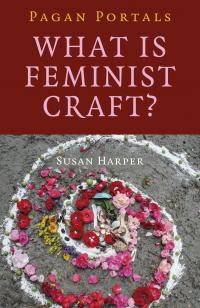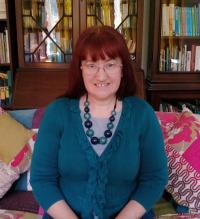
[caption id="attachment_6564" align="alignleft" width="300"] Looking back along Brean Down through the gate of the fort.[/caption]
Looking back along Brean Down through the gate of the fort.[/caption]
I've never written up a "bucket list" - too much I'd fail to achieve, I suspect - but there are certain places that I've felt drawn towards, and often they are places that have cropped up here and there in occult literature. Given that we were on a trip to explore locations associated with Dion Fortune, it was almost compulsory to take a trip to the setting of her best-known novel, The Sea Priestess.
In that story the central female character (I hesitate to write "heroine") is one Lilith Morgan Le Fay, a highly trained magician somewhat heavily based on Dion Fortune herself, or at least on an idealised self-portrait. I don't want to digress too far into a precis of the narrative, here, but in brief Le Fay establishes a temple to the ancient sea gods on the site of a derelict fort, standing at the tip of a peninsula that reaches out from a marshy region at the mouth of a river, into the sea.
The fictional setting was based on an actual peninsula, Brean Down, which points like a finger into the Bristol Channel, a few miles south of Weston Super Mare. A little over an hour's drive from Glastonbury, as it happens, so with the car packed we said our farewells to the George and Pilgrims, and set off into the west.
When Dion Fortune stumbled across Brean Down - judging from her vivid descriptions in The Sea Priestess, at least - it was quite isolated, shrouded by that aura of mystery and separateness that often hovers across marshlands. It's a bit different, nowadays. Acres of caravan parks and holiday camps stretch out alongside the road leading through Brean and to the Down itself. There's a "family theme park", too. The long ribbon of the beach, which must once have been a lonely stretch of sand, now hosts crowds of holidaying families from the Midlands. Although the marshes are still there, somewhere behind the facade of caravans and funfair rides, I don't think Fortune would recognise it as the same place.
But the underlying geography is the same. The flat marshy land, threaded with narrow streams and split by the River Axe, underneath its garish contemporary accretions is much as Fortune would have known it. As is the high bulk of Brean Down itself, rising abruptly from the flat lands and piercing the waters of the Bristol Channel like a needle.
Another change from Dion Fortune's time is that Brean Down is now owned and maintained by the National Trust. It remains free to access, but the NT involvement brings with it the usual sort of extras - the car park, the shop full of souvenirs, and the cafe. While the car park is free and the cafe at least is not unwelcome, all this means that Brean Down has become something of a tourist attraction. It was busy.
Access to the Down may not have an entrance charge, but it's...interesting. The obvious route, and the one most visitors use (perhaps because it's so readily visible) is a very long and narrow stairway that snakes up the cliffs to the top of the Down. It's quite a climb. I think it took us about fifteen minutes to reach the top. Once up there, it's another long and sometimes rough walk to the tip of the peninsula and to the ruined fort that, in The Sea Priestess, Lilith Morgan Le Fay converts into her temple. By the way, it's wise to be careful on the walk. Aside from anything else, the southern flank of the Down is an abrupt drop down the high cliffs. An information leaflet we picked up on arrival gives a rather lurid warning about the number of dogs that go bounding heedlessly over the edge - at least one every month, apparently!
Like the rest of the Down, the fort tends to get relatively crowded (it might be less so on a day of bad weather, but...) and there are National Trust volunteers in attendance as well as a number of information boards where you can learn about its real history. The fort is pretty much as you'd expect a derelict Second World War fort to be. Le Fay's temple was (obviously) a fiction - but it's quite easy to visualise on location, and that in itself could lead to some interesting magical experiments at a later date.
For those who don't want to trek along the top of the Down, there's a narrow road that runs the length of the peninsula on its northern side. It's a slightly longer walk (it runs beyond the point where the stairs climb the cliffs on the other side, then curves back to take you down an easier slope to the cafe and shop), but frankly if you want to avoid the steep steps and the possibility of stumbling over rocks, it's the better option. I wouldn't go so far as to describe the fort as "wheelchair accessible", but as we were going back down that slope we were passed by a woman on a mobility scooter headed on her way up. Her scooter was struggling with the incline - but she didn't come rolling backwards past us, so I presume she managed the climb, albeit slowly!
Somehow, my actual experience of Brean Down has not really dissipated the magical vision that I acquired from my reading of The Sea Priestess. This raises an interesting question (well, interesting to me at any rate). Any location will contain at least echoes of its own history that can be picked up on. But can a location also contain echoes (or perhaps reflections) of a fictional representation? This is a point to experiment with and explore.
A physical visit to the site is absolutely necessary for any such working with it. One needs the actual feel of the place, not merely some visual image that could be derived from a photograph. In the case of Brean Down, there's still a wildness to wave and wind and the lingering loneliness of the marshes that is untamed by - cannot be tamed by - any number of caravans and theme park rides. If you want to work with that wildness, you have to feel it in your bones and in your soul.
Categories:
0 comments on this article






